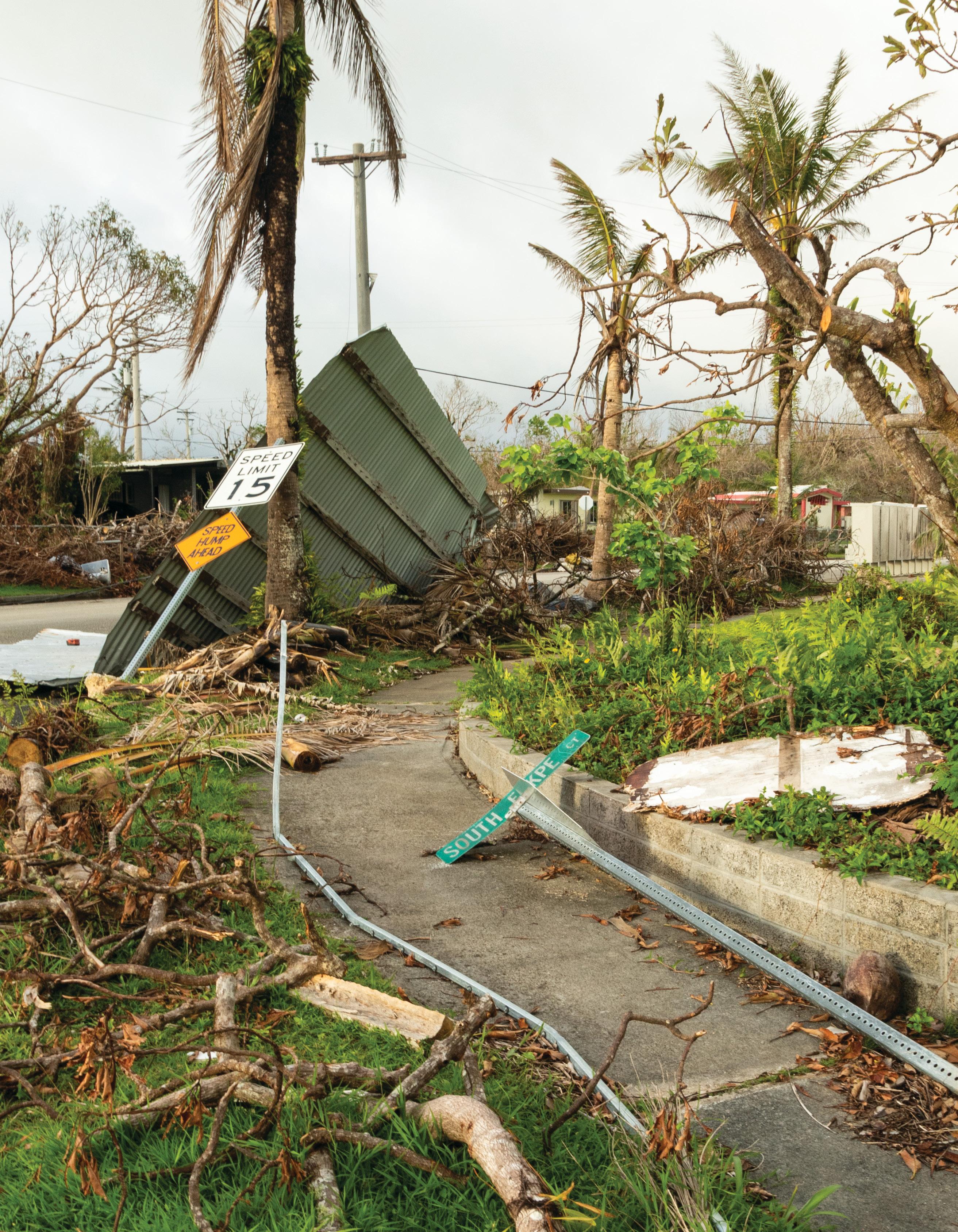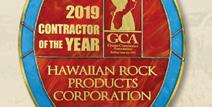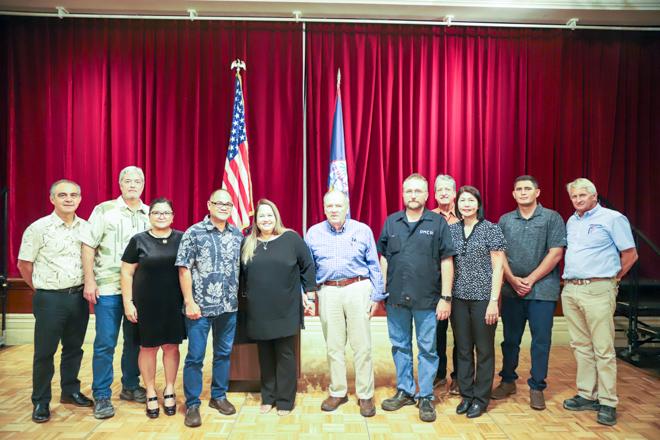ROAD TO RECOVERY


VOL. 64 ISSUE 6 JUNE 2023 • GUAM CONTRACTORSʼ ASSOCIATION
GET THE BEST TOOL AROUND WITH THE ALL-NEW CAT® CENTRAL APP
Order parts and get support when you need it — anytime, anywhere. The all-new Cat® Central app offers features that put a whole lot of power in your hands. Find local pricing and in-stock availability for parts, get support and maintenance info whenever you need it and use the scan feature to immediately access information tailored to your asset. We’ve put it all in one place. That’s Cat Central.


Download the app now to get access to parts and support whenever you need it!
hawthornecat.com
GCA Construction News Bulletin March 2023 Ad-Cat Central.indd 1 3/1/23 2:14 PM




2 TABLE OF CONTENTS JUNE 2023 JUNE 2023 12 HAVE A STORY IDEA? LET US KNOW! email taco@adztechguam.com WOULD YOU LIKE TO SEE SOMETHING COVERED? 16 BUILDING PERMITS 23 12 FEATURE STORY 16 FEATURE STORY 21 NEWSLINE 10 MEMBER BENEFITS 24 REPORTS/ INFORMATION 20 PHOTO HIGHLIGHTS 08 NAWIC NEWS











THEDIRECTORS THEEDITORIALS
PRESIDENT
James Martinez
Guam Contractors’ Association
PAST CHAIRMAN
Bill Beery
Tutujan Hill Group
CHAIRMAN
Joe Roberto
East Island Tinting
VICE CHAIRMAN
Matthew Hunter
Dylan Mechanical Construction Services
SECRETARY/TREASURER
Kathleen David
Pacific Rim Constructors
CONTRACTOR DIRECTORS:
Don McCann
Black Construction Corporation
William Best
SmithBridge Guam
AJ Perez
Hawaiian Rock Products
Brian Holm
Hensel Phelps
Soraya Vongjalorn
Vertex Guam
ASSOCIATE DIRECTORS:
Mark Cruz
MidPac Far East
Jose Garcia
First Hawaiian Bank
Camilo Lorenzo
Matson Navigation
Geri Leon Guerrero
Adztech Advertising and PR
THETEAM
Guam Contractor’s Association (GCA) in conjunction with Adztech and Public Relations, Inc. publishes the Construction News Bulletin (CNB) monthly. Reproduction of materials appearing in this publication is strictly forbidden without written permission by GCA.
While we always strive for accuracy, we will from time to time overlook mistakes. In order to help us improve the quality and accuracy of this publication, we ask that you take the time to look at the information provided and notify GCA or Adztech of any corrections as needed. Opinions and editorial content of this publication may not necessarily be those of the publisher, production team, staff, GCA members, GCA Board of Directors and advertisers.
For more information about advertising in the GCA Construction News Bulletin contact the advertising department at (671) 477-1239/2239 or email at adztech@teleguam.net.
Distributed to GCA members or can be obtained by stopping by the Guam Contractors’ Association office located at 506 Mariner Ave., Barrigada, Guam 96913
To find out more about how you can become a GCA member contact Guam Contractors’ Association at Tel: (671) 647-4840/41 Fax: (671) 647-4866 or Email: gca@teleguam.net. www.guamcontractors.org
Postmaster. Send address changes to Guam Contractors’ Association, located at 506 Mariner Ave., Barrigada, Guam 96913
PUBLISHER: James Martinez
PRODUCTION TEAM
LEAD:
Geri Leon Guerrero
AD SALES: Alyssa Roces
PRODUCTION:
Alyssa Roces
Christopher “Taco” Rowland
PHOTOGRAPHY:
Alyssa Roces
Christopher “Taco” Rowland
EDITOR:
Adztech
CONTRIBUTING WRITERS:
Dr. Sam Mabini Young, BOD
Nickolas Florez
Rodney “RJ” Ricarte
GCA STAFF:
Desiree Lizama
Elaine Gogue
Francine Taitague
Trevor Cruz
COVER:
Mawar, our first real storm in 2 decades, has left it’s mark on the island. But working together we can get our island back on track.
GCA Building Skills For A Lifetime
TRADES ACADEMY
4 EDITORIALS www.guamcontractors.org JUNE 2023 CONSTRUCTION NEWS BULLETIN
Guam Contractors Association
FRIDAY
July 7, 2023
Starts Golf Resort
SHOWTIME 11:00 AM
FRIDAY
Sept. 1, 2023
Starts Golf Resort
TEE TIME 12:00 PM
FORMAT

THREE-PERSON TEAM MODIFIED SCRAMBLE FEES
$375 PER TEAM PER TOURNAMENT
COMBO SPECIAL!
REGISTER FOR BOTH TOURNAMENTS AND GET A DISCOUNT!
CHIP IN! WE HAVE GAMES + RAFFLES!
MORE CHANCES TO WIN CASH PRIZES!
Proceeds will benefit the GCA Trades Academy scholarship fund and GCA Outreach Programs.
Sponsored by:
-raiser 35th
Scholarship Tel: (671) 647-4840/41
www.guamcontractors.org
Annual
•
CHAIRMAN’S LETTER
Dear Membership,
Your Board of Directors, active and driven Committees, goal driven staff and management continues its forward momentum in inform, employ, educate and represent each of you proudly. Keep in mind, after each monthly luncheon meeting, a very short survey is requested if there is anything more the GCA could do for YOU!
There was a question asked, “who are we?”
Well, with the expectations of excellence, time always being a challenge, the accuracy of estimates, Guam’s hot sun on our backs, the joy of completions, a high level of humidity surrounding us, a renewed mindset of achievement, callouses on our hands, the fairness and best shop practices, stress load on our shoulders, consistent communications between our local, federal Government and the military, and safety being paramount, collectively whether we work in an office, out in the field, high above towers or down below in tunnels, to answer the question, it is and shall always be, we are the GUAM CONTRACTORS ASSOCIATION!
Best wishes,
Joe Roberto Chairman

6 CHAIRMAN’S LETTER www.guamcontractors.org JUNE 2023 CONSTRUCTION NEWS BULLETIN
“East Island Tinting made it easy for me when I needed some tint for Meskla, my restaurant. On top of the options that they gave me, they were fast, friendly, informative, and the quality of their work is excellent! The best part is that they guarantee their work! It was a pleasure doing business with them.”
 Peter Duenas Owner
Peter Duenas Owner



East Hagåtña 477-TINT (8468) / 472-TINT eastislandtinting@guam.net

Construction a Positive Career Move for Female Workers
“Construction is often overlooked as a career opportunity by women. Yet, the industry offers female construction workers a wide range of jobs and one of the lowest gender pay gaps. The industry is rebounding towards pre-pandemic workforce levels and is expected to grow as a result of the passage of the Infrastructure Investment and Jobs Act, too.” (National Association for Women in Construction’s online article of March 20, 2023)
Opportunities in Construction Work
As in the CONUS, Guam has numerous construction-related job opportunities for women. According to the 2020 Census, 54% of Guam’s working adult population were women. By December 2022, the Guam Department of Labor, Bureau of Labor and Statistics (GDOL/BLS) reported 10,820 (17%) of workers were in construction. Of the total number of construction workers, only 890 (8.2%) were women in construction. That means that less than 2% of working women in Guam are with the local construction industry.
Compare Guam’s number to the national average of 13% of women employed in construction (USDOL Bureau of Labor & Statistics), and the top three states holding the highest share of women in construction-industry jobs are: Washington, D.C. (17.6%), Arizona (15.6%) and Texas (14.5%).
In a study by Construction Coverage, Minneapolis, Minnesota, was the top city generating 1,300 women construction workers or 19.1% female employment share. Close second was Seattle, WA, with 2,700 female construction workers or 17.6% of the workforce. Third was San Francisco, CA, with almost 3,000 female construction workers or a 17% employment share. Furthermore, opportunities and rates of women in construction appear to increase in Southern and Western cities. For example, in Sandy Springs, GA,
By Dr. Sam Mabini Young, BOD
women make up almost 31% of that city’s construction workforce.
Opportunities
in Increased Livelihoods Guam’s military buildup equates to the increasing developments of urban areas happening in the CONUS, which boosts the volume of construction job opportunities and access to higher pay and related benefits. Although it is not surprising that stateside construction jobs usually pay higher (i.e. Alaska boasts the highest median annual wage of $61,614 for women in construction, and Vermont with $54,340/annum), Guam’s construction jobs still pay comparably higher than other industries.
According to GDOL/BLS December 2022 employment report, Guam’s average annual earnings for women in construction is $36,500. Though, it appears that majority of female workers in Guam are employed in other industries. To recognize the significant financial implications of job choice, consider how local women were primarily employed in the following top five sectors, with average annual earnings in parenthesis: Hotel/Lodging ($19,338); Retail ($19,697); Printing/Publishing ($24,108); Finance/Insurance ($29,923); and other Services ($28,196).
Although women could benefit professionally and economically by joining the construction industry, many women continue to miss the great opportunities. There are rewarding construction-related professional, administrative, or office positions available. These include jobs such as project management, human resources, procurement, administrative support or sales. Many women also train for highly skilled trades positions that come with incredibly competitive salaries, such as those in electrical, plumbing, carpentry, welding, metal work, heavy equipment operation, and others.
More work is needed to attract and educate women about the construction field, as well as improve wage equity.
According to recent USDOL BLS data, women in construction earn on average 95.5 percent of men’s earnings. This is still better than the 82.9% of overall earning of women to men’s income. The work continues, and opportunities abound.
Career development for female construction workers
Whether you are in Guam or in the North, South, East or West of CONUS, a small town or metropolitan, NAWIC provides opportunities for connection, education, and leadership development for female construction workers. Guam NAWIC continue to support and encourage local women to take part in the growing job opportunities in construction that can further their economic and professional development.
NAWIC Resources:
• The Annual Conference held in August features professional and personal development sessions, opportunities to learn about the latest trends and cutting-edge technology, and networking with professionals from all over the country. Learn more about the 2023 Many Paths, One Mission conference here.
• The NAWIC Education Foundation provides professional certification programs for career advancement, as well as programs to introduce the next generation to the construction industry. Learn more here.
• A wealth of education resources are available on the website at nawic.org.
• Local chapter membership provides additional opportunities for professional development as well as support, mentorship, and networking. Find a chapter near you here.
About NAWIC
The National Association of Women in Construction is the leading association for women builders with more than 5,000 members and 118 chapters across the US and affiliates world-wide. NAWIC provides members with community, mentorship, networking, leadership and educational opportunities. For more information, visit nawic.org.

8 NAWIC NEWS www.guamcontractors.org JUNE 2023 CONSTRUCTION NEWS BULLETIN




WHY ADVERTISE IN THE GCA CNB? LOCAL AND NATIONAL CONTRACTOR & ASSOCIATE MEMBERS GOV GUAM AGENCIES GUAM LEGISLATURE MAYOR’S COUNCIL BENSON MARK’S HARDWARE EAST WEST RENTAL GUAM HOME CENTER S.A.M.E. MILITARY CONTRACTING OFFICES GCA MEMBERSHIP LUNCHEONS • • • • • • • • • • • 1,000 COPIES PRINTED MONTHLY GLOBAL REACH VIA GCA WEBSITE WWW.GUAMCONTRACTORS.ORG • MOBILE DEVICE CONVENIENCE. • EASY TO READ ANYTIME. • MEMBER DRIVEN • GUAM’S ONLY CONSTRUCTION PUBLICATION NEW! YOUR ONLINE AD IS LINKED TO YOUR WEBSITE
The TakeCare mobile app: Get the information you need when you need it.
By Rodney “RJ” Ricarte
Where can TakeCare GCA Employee Health Insurance Benefit members get information about their healthcare benefits? TakeCare offers a convenient mobile app on the iPhone and Android platforms that can manage your healthcare benefits and can provide you the information you need about other benefits and services.
So what can the TakeCare mobile app do for you?
It’s mobile … It goes where you go. The location search feature finds nearby providers, pharmacies and clinics. The complete TakeCare in-network provider directory is always with you, the GCA member, in the mobile app.
It’s personal … TakeCare members can view their member identification card information.
It eliminates paper ... No more paper fitness stamp cards, Affinity Rewards cards, provider network directory, and member identification card. Everything is always digital and with you no matter where you go.
It’s secure … Keeping health information private is very important. Members can rest assured that the information is absolutely confidential.
Get the latest alerts and notifications! Members receive alerts and bulletins about the latest TakeCare news/promotions/offerings as well as health tips and wellness class schedules. The provider network information is real-time. Whenever TakeCare adds or removes a provider, that information is reflected almost immediately on the mobile app and on the website.
Get the latest wellness & fitness Incentives. See latest fitness calendar and the newly added biometrics feature, helping members to keep track of their wellness and fitness progress. The digital fitness stamp cards allow quicker, easier and a more convenient way to pay out fitness cash incentives. TakeCare is the only insurance carrier in the region that provides an app that tracks member’s workouts and automatically pays incentives.
Don’t forget the Affinity Rewards Discount Program. Employer groups who sign up with TakeCare can highlight their business in the mobile app (at no cost) through the Affinity Rewards discount program. Discounts offered only for TakeCare members.
Saving time and managing healthcare services is the goal of the TakeCare mobile app on your smartphone. Take advantage of this valuable resource!
Download the TakeCare Mobile App at the Apple App Store and Google Play.
Rodney “RJ” Ricarte is the TakeCare account executive for GCA. He can be contacted at (671) 487-7121 or rodney.ricarte@takecareasia.com.
10 MEMBER BENEFITS www.guamcontractors.org JUNE 2023 CONSTRUCTION NEWS BULLETIN

Typhoon Preparation and recovery


On May 24, 2023, Typhoon Mawar slammed into Guam, pulling apart homes, peeling off portions of warehouse roofs, flooding parking lots and the cars on them, stripping leaves off trees and tearing up carefully landscaped lawns. Mawar also threw trees and debris on power lines and telecomms towers, and jammed water and wastewater facilities and pipelines.

The kicker? As harsh as Mawar was with its sustained winds of 140 mph with gusts over 150 mph, Guam was spared the worst of it. Just 24 hours before it barreled through Guam, Mawar weakened from a super typhoon with sustained winds of 160 mph-plus and gusts up to 180 mph.
Looking back at other typhoons that hit Guam, the opposite has happened — Super Typhoon Pongsona gained its "super" strength not long before it let loose on our island on Dec. 8, 2002. These are examples of how unpredictable mother nature can be.
Charles Esteves, Administrator of Guam's Office of Civil Defense, said it underscores why residents and businesses alike should take time to prepare for the storm itself as well as what they need to do to reopen.
Esteves said it's critical for businesses to have what's called a business continuity plan. You have to determine what your business will do if you lose communications, inventory, etc., he said.
"The plan can be used to identify interdependencies, friction points, and points of failure in a business," he said. "I recommend they do a thorough damage assessment and work with their insurance companies to determine what they can claim."
Esteves said by preparing their plans, they can modify operations to resume operations quicker. He recommended businesses create a continuity plan that can help
1. C ontact all staff and establish their location and whether they are safe and well – ask whether they have been affected, will they be able to return to work, and if so when will they be able to return to work.
2. Undertake an initial damage assessment – If you are allowed to access your premises, develop a list of destroyed or damaged items. If possible, estimate their replacement costs. Include photos of the damage if possible. Do not commence cleaning up until you have contacted your insurer.
3. Contact your insurance company and discuss your damage assessment, your level of cover, how quickly your claim can be processed, how much and in what form a claim will be paid and when an insurance assessor will visit.
4. If safe to do so, salvage any remaining equipment and stock
While many local businesses were able to reopen following Mawar, many had to open with limited hours or restricted operations and/or inventory because of damage to the facility or inventory. Lack of power was a large issue for residences and businesses alike, but the shortage of fuel at gas stations made it difficult to run generators. The power issue also impacted telecoms company, making phone calls an issue but it also meant Guamanians couldn’t use debit or credit cards at stores and gas stations.
The Guam Chamber of Commerce surveyed members shortly after the storm. According to respondents, about half were able to reopen after the storm; 30% opened with limited hours; and 17% remained closed.
After Mawar, the Guam Chamber of Commerce and Guam Hotel and Restaurant Association shared information with media on what businesses were open and what were closed.
FEATURE STORY facebook.com/GuamContractors JUNE 2023 CONSTRUCTION NEWS BULLETIN 13
PREPARING FOR A POSSIBLE STORM
It's been about 20 years since Guam has seen a typhoon as strong as Typhoon Mawar. That's just one of the ways Mother Nature can be unpredictable. Even the most knowledgeable meteorologists can't accurately predict where and when a storm will strike and how strong it will be when it does. Being over prepared is better than being under-prepared. Here are some ways business owners and managers can prepare their offices and facilities for a potential typhoon.
BEFORE THE STORM
1. Secure outdoor furniture, propane tanks, equipment, and other items that may become airborne during high winds.
2. Trim dead or weakened branches from trees around buildings to reduce the risk of them falling into the building and causing damage.
3. Remove clogged gutters and downspouts to help prevent water from pooling around the building and parking lot.
4. Put up or close storm shutters
5. Prepare backups and store offsite all computer records (i.e. Payroll, inventory records, etc.).
6. Identify critical business functions that absolutely must continue (i.e. shipping, inventory control, payroll) and come up with processes to ensure these will carry on. Consider investing in a generator or other portable power sources in case of an extended power outage.
7. Prepare for possible flooding/water leaks by sealing unprotected windows, stacking sandbags near doors where flooding is typical. Cover computers and other electrical equipment with large plastic bags and/or raise items off the ground.
8. Take pictures before (and after) the event to support insurance claims.
9. Check insurance coverage regularly to make sure you’re adequately protected.
10. Check with the Guam Office of Civil Defense/Homeland Security for up-to-date information on storm information and other necessary safety procedures.
11. Ensure your vehicles have full tanks in case gas stations aren't able to open after a typhoon; and park vehicles in protected areas.
12. Ensure there's a clear plan for staff/employees ahead of time, if the typhoon hits are they required to come into work as soon as Condition 4 is called? Who do they call if they can't come in and what happens if that person can't be reached?
13. Have an emergency communication plan in place so employees can stay in touch if lines of communication are disrupted.
14. Use emergency shutoffs to turn off electricity, gas, and other utilities if they pose a risk of damage to your property.
15. Have a plan for restoring power, communications, data, and other services.
DURING THE STORM
1. Stay indoors and stay away from windows and sliding glass doors.
2. Conserve power on your cell phones as much as possible.
3. Stay informed. Listen to the local media or NOAA Weather Radio for the latest weather bulletins. It's critical that you and your team understand what's going on, if what's being experienced is the passage of the eye of a typhoon, there
1. Stay indoors until the all-clear is given by government officials.
2. Do not touch any loose power lines. Call Guam Power Authority.

3. Wear protective clothing, including masks, goggles, and gloves, when engaging in cleanup activities.
4. Take photos of any damage to property.
5. Call your insurance company
6. Follow your plan to get your office/business back up and running.
7. Contact the Guam Office of Civil Defense/Homeland Security at 671-475-9600 for more information if needed.
FEATURE STORY 14 www.guamcontractors.org JUNE 2023 CONSTRUCTION NEWS BULLETIN
TROPICAL STORMS & TYPHOONS
Guam has seen everything from a tropical storm to what's called a super typhoon. Here's a breakdown of the categories for each:
2 Tropical Storm Categories
Tropical Storm Category A: “Weak Tropical Storm”
• Sustained winds: 30-49 mph
• Peak Gusts: 40-64 mph
• Damage only to the flimsiest lean-to type structure. Minor damage to banana and papaya trees.
Tropical Storm Category B: “Severe Tropical Storm”
• Sustained winds: 50-73 mph
• Peak Gust: 65-94 mph
• Major damage to huts made of thatch or loosely attached corrugated sheet metal or plywood; sheet metal and plywood may become airborne. Minor damage to buildings of light materials. Moderate damage to banana and papaya trees.
Typhoon Categories
1: “Minimal Typhoon”
• Sustained winds: 74-95 mph
• Peak Gust: 95-120 mph
• Corrugated metal and plywood stripped from poorly constructed or termite infested structures and may become airborne. Few wooden, non-reinforced power poles tilted and some rotten power poles broken. Less than 10% defoliation of trees/shrubs. Palm fronds begin to break.
2. Typhoon Category 2: “Moderate Typhoon”
• Sustained winds: 96-110 mph
• Peak Gust: 121-139 mph
• Damage to wooden and tin roofs and other structures of termite infested or rotted wood. Considerable damage to structures made of light materials. Several rotten wooden power poles snapped and many non-reinforced power poles tilted. Some secondary power lines down. 10-30% defoliation of trees/shrubs.
3. Typhoon Category 3: “Strong Typhoon
• Sustained winds: 111-129 mph
• Peak Gust: 140-164 mph
• Extensive damage to wooden structures weakened by
CONDITIONS OF READINESS (COR)
It's important to understand Conditions of Readiness, often referred to as COR, are about the timing and not the strength of the storm. From 4 to 1, the CORs are like a countdown. COR 4 is a "normal day" in paradise and COR 1 means you better be indoors because the storm is expected soon or it's here. The governor of Guam, based on recommendations from National Weather Service and other officials, will make this determination. Here's the breakdown from the Guam Office of Civil Defense/Homeland Security:
• Condition 4: damaging winds possible within 72 hours
• Condition 3: damaging winds possible within 48 hours
• Condition 2: damaging winds expected within 24 hours
• Condition 1: damaging winds expected within 12 hours or are occurring
termite infestation, wet and dry wood rot, and corroded roof straps. Structures made of light material may be destroyed. Some roof, window, and door damage to wellbuilt, wooden and metal buildings. Air full of small flying debris. Few hollowed-spun concrete power poles broken or tilted and many non-reinforced wooden power poles blown down or broken. Many secondary power lines down. Palm trees begin to lose crowns; 30-50% defoliation of trees/shrubs.
4. Typhoon Category 4: “Very Strong Typhoon”
• Sustained winds: 130-156 mph
• Peak Gust: 165-198 mph
• Many well-built wooden or tin homes damaged or destroyed and complete destruction of buildings made of light materials. Extensive damage to non-concrete roofs. Some reinforcedhollow-spun concrete and many reinforced wooden power poles blown down with numerous secondary power lines downed. Tree/shrubs 50-90% defoliated; trees being to loose bark.
5. Typhoon Category 5: “Devastating Typhoon”
(These have been dubbed "Super Typhoon" by media but the term is getting more and more common)
• Sustained winds: 157-194 mph
• Peak Gust: 199-246 mph
• Total failure of non-concrete reinforced roofs. Extensive or total destruction to non-concrete residence and industrial buildings. Severe damage to some solid concrete poles, to numerous reinforced hollow-spun concrete power poles, to many steel towers and virtually all wooden poles. All secondary power lines, most primary power lines downed Considerable glass failures due to flying debris and explosive pressure caused by extreme wind gusts; well constructed storm shutters fail. Trees devoid of all but largest stubby and sandb lasted branches; up to 100% defoliation. Large airborne debris.
WATCHES AND WARNINGS
The National Weather Service is always on the lookout for weather patterns that will impact the island. If there's a storm heading our way, they'll announce either a watch or a warning. It's typically in conjunction with advisories on flooding or high surf and winds, the latter two being particularly important for mariners. But the two to listen out for are:
• Watch: damaging winds possible within 48 hours; tropical storm or typhoon
• Warning: damaging winds expected within 24 hours; tropical storm or typhoon
Source: Guam Office of Civil Defense/Guam Homeland Security
FEATURE STORY facebook.com/GuamContractors JUNE 2023 CONSTRUCTION NEWS BULLETIN 15
Overhead Field Field Overhead
 By: Nickolas Florez
By: Nickolas Florez
Field overhead – direct or indirect cost?
For federal construction contracts, the Federal Acquisition Regulation (FAR) allows for certain field overhead costs to be chargeable as indirect or direct costs for contract modifications, provided that these costs are consistently applied. Specifically, FAR 31.105(d)(3) states,
“Costs incurred at the job site incident to performing the work, such as the cost of superintendence, timekeeping and clerical work, engineering, utility costs, supplies, material handling, restoration and cleanup, etc., are allowable as direct or indirect costs, provided the accounting practice used is in accordance with the contractor’s established and consistently followed cost accounting practices for all work.”
While this is simple enough in concept, there remains confusion as to how this FAR requirement is actually applied in practice and an even greater misunderstanding of the significance of how accounting for field overhead costs as a direct cost versus an indirect cost will impact the total amount of recovery obtained on a given contract modification. The difference can be staggering, particularly where time-related changes are involved in the change. To demonstrate the difference in accounting for field overhead costs as a direct cost or an indirect cost, three examples are presented below.
Example 1: Add $100,000 in craft labor, material, equipment with no time added to the contract. For purposes of providing a simplified calculation, all examples below assume an indirect cost rate of 10% for the indirect cost calculation and a direct cost calculation of $1,000/day when a direct approach is used. Again, the FAR allows either a direct cost methodology or an indirect cost methodology.
Example 1 calculation with field overhead of 10% as an indirect cost:
Total cost = direct costs + indirect = $100,000 + ($100,000 x .10) = $110,000
Example 1 calculation with field overhead of $1,000/day as a direct cost:
Total costs = direct costs = $100,000 + ($1,000/day x 0 days) = $100,000.
In this case, where the change does not extend performance of the contract, the indirect cost methodology produces the highest return of total costs. Assuming that no additional field overhead staff is needed to execute the change, the contractor actually gains a slight windfall because field overhead is already accounted for in the base bid of the contract.
Example 2: Add $100,000 in craft labor, material, equipment with a
100 calendar days added onto the contract.
Example 2 calculation with field overhead of 10% as an indirect cost:
Total cost = direct costs + indirect = $100,000 + ($100,000 x .10) = $110,000
Example 2 calculation with field overhead of $1,000/day as a direct cost:
Total costs = direct costs = $100,000 + ($1,000/day x 100 days) = $200,000
In this case, where there are two components of direct costs, one associated with changed work and the other with the extension of time (extended field office overhead), the direct cost methodology can result in a significantly higher cost of the change. This will not always be true, depending on the specifics of the change, but this example does show the sensitivity of the total costs as a function of time.
Example 3: No additional craft labor, equipment or material, but 100 calendar days of time added onto the contract. Example 3 calculation with field overhead of 10% as an indirect cost:
Total cost = direct costs + indirect = $0 + ($0 x .10) = $0
Example 3 calculation with field overhead of $1,000/day as a direct cost:
Total costs = direct costs = $0 + ($1,000/day x 100 days) = $100,000
In this case, where the only contract change is time, the direct cost methodology is always the preferred choice because the indirect methodology will always result in zero total costs. The example above assumes that time extended on the project is compensable. If the time provided on the contract change is not compensable, either methodology produces the same result of zero costs.
Example 1, 2 and 3 Summary:
As can be seen from the table above, where there is no time added to the contract (Example 1), the indirect methodology will always result in higher recovery. Where both time and labor/material/equip is added (Example 2), the results will vary depending on the details of the change, but the total recovery is clearly very sensitive to time-related costs. As shown in example 2, the time-related costs can quickly exceed the labor/material/equipment costs. Where additional time
Example 1 $ 100,000 0 $ 110,000 $ 100,000 Example 2 $ 100,000 100 $ 110,000 $ 200,000 Example 3 $ - 100 $ - $ 100,000 Lab Mat Equip Time (CDs) Total recovery using indirect methodology Total recovery using direct methodology Example FEATURE STORY facebook.com/GuamContractors CONSTRUCTION NEWS BULLETIN 17 JUNE 2023
is added to the contract, direct costs methodology will always result in a higher recovery of field overhead costs.

Relevant Case law:
Now armed with the understanding of how to account for field office overhead costs to provide for the best recovery depending on the change, one would be tempted to switch methodologies depending on the specifics of the change order; however, I would caution against this practice. In 2012, NAVFAC awarded a contract to Watts Constructors LLC. to relocate a sewer lift station. Shortly after award of the contract, the Navy informed Watts that they must employ a consistent methodology for computing field office overhead on all changes, either a percentage rate (indirect) or a per diem basis (direct). Watts responded that they would be using a percentage rate. During the course of the work, several modifications, which did not extend time on the contract, were bilaterally executed based on proposals utilizing an indirect cost rate for field overhead. On a later modification that did include a time extension to the contract, Watts provided a proposal with field overhead accounted for as a direct cost. The Navy denied the proposal on the basis that Watts was not allowed to switch methodologies. Watts submitted a claim and subsequent appeal citing that the indirect cost methodology does not allow for the recovery of the actual costs expended and those costs were due to government caused delay. The court, citing Mortensen in dicta, states:
“We see no convincing rationale for routinely using different job site overhead distribution bases on changes that extend or shorten contract performance, say, by one day (or one week, or one month), and changes that do not.... Even when a contractor proves it has failed to recover its entire overhead, that is insufficient justification for permitting an accounting change from one distribution base to another…”
The court denied Watts' appeal concluding that even if the percentage rate method for recovery of field overhead does not fully compensate Watts for all costs incurred, that fact in and of itself does not entitle Watts to change methodologies.
While the decision seems a bit harsh, it is entirely consistent with FAR 31.105(d)(3), which while allowing the contractor to select either a direct or indirect methodology for accounting for field overhead, the contractor cannot switch methodologies midstream.
About the Author: Nickolas Florez is a Certified Forensic Claims Consultant and former Contracting Officer with both NAVFAC and USACE with over 35 years of experience in construction and contracting with the federal government; Ph 671-682-9020.
FEATURE STORY

Hilton Guam Resort



20 PHOTO HIGHLIGHTS www.guamcontractors.org JUNE 2023 CONSTRUCTION NEWS BULLETIN
GCA May Luncheon
May 17th, 2023
NEWS LINE
Frequent Safety Meetings Enhance Supervisor Training on Substance Abuse Prevention
Safety training equips supervisors to lead and manage projects, people, processes and policies. This training is enhanced through frequent, regularly scheduled safety meetings involving supervisory staff and the company safety director. These intentional, agenda-driven meetings go beyond training and education, helping to develop relationships as challenges and successes are shared.
Substance abuse prevention should be a topic not only for supervisory safety training, but the challenges and successes surrounding it should also be a topic of discussion for supervisory safety meetings. With the state-by-state legalization of recreational cannabis, substance use needs to be addressed. It is crucial to understand local laws and company policies.
Whether through legal or illegal use, the construction industry has suffered from the effects of substance impairment for decades. Some companies are responding with high-tech impairment recognition devices or smartphone apps that measure cognitive function or eye response or can even detect cannabis in saliva. Other companies are doubling down on high-touch impairment recognition by starting each day with a huddle that allows the crew leader to evaluate impairment as they perform task-specific planning (Job Hazard Analysis, Activity Hazard Analysis, Pre-Task Plan, etc.) and a stretch and flex. Likewise, some companies are adapting their behavior-based safety observation system to include recognition of possible impairment.
As a company’s safety culture matures, safety meetings with the
supervisory staff and safety director will eventually provide the value of a peer group. Safety directors have shared stories of the first time they got a call from a superintendent who proactively asked for advice a week before a critical lift or complex operation. Others shared that superintendents call each other more often for safety advice due to these meetings. Everyone needs a group to belong to where they are heard, understood and willing to hold each other accountable.
Times are changing, and supervisors need to be engaged and equipped to ensure the right things happen at the right time and for the right reason. Holding regular safety meetings creates the environment in which supervisors are set up for success.
Supreme Court Issues Ruling Narrowing Scope of WOTUS
On May 25, the U.S. Supreme Court issued a decision in the Sackett v. Environmental Protection Agency case, narrowing the scope of “waters of the United States” that may be regulated under the Clean Water Act.
The court’s decision rejected the “significant nexus” test and curtailed federal regulation to traditional navigable waters and other waters that are relatively permanent and connected to them. The ruling rejects the broad scope of WOTUS that the Environmental Protection Agency and U.S. Army Corps of Engineers have claimed jurisdiction over.
ABC applauded the ruling, stating in part:
“By rejecting the ‘significant nexus’ test, the Supreme Court took a critical step toward eliminating the costly regulatory uncertainty that has plagued construction projects around the country for decades without providing meaningful environmental protections for America’s waterways.”
The decision also challenges the Biden administration’s ABC-opposed 2023 WOTUS final rule, which relied heavily on the “significant nexus” test.
Additional rulemaking or guidance documents will likely be necessary to bring the rule into compliance with the court’s decision.
The agencies have yet to provide clarity on next steps, with the EPA issuing a statement in opposition to the ruling and stating on its website that “the agencies will interpret the phrase ‘waters of the United States’ consistent with the Supreme Court’s decision in Sackett.”
NEWSLINE facebook.com/GuamContractors JUNE 2023 CONSTRUCTION NEWS BULLETIN 21
Treasury Releases Guidance on IRA Advanced Energy and Low-Income Communities Tax Credits
On May 31, the U.S. Department of the Treasury and Internal Revenue Service released additional guidance and proposed rules on the Inflation Reduction Act’s advanced energy project and Low-Income Communities Bonus Credit Program tax credits.
The ABC-opposed Inflation Reduction Act was signed into law on Aug. 16, 2022, and provides over $270 billion in tax credits for the construction of solar, wind, hydrogen, carbon sequestration, electric vehicle charging stations and other clean energy projects. Specifically, Subtitle D-Energy Security of the IRA grants developers/taxpayers a bonus tax credit five times greater than a baseline tax credit of 6% conditioned on requirements that project contractors meet prevailing wage and government-registered apprenticeship program utilization requirements outlined in the legislation and IRS guidance.
The advanced energy project credit allocation provides additional guidance regarding $10 billion in tax credits for projects including the construction of facilities for clean energy manufacturing and recycling, greenhouse gas emission reduction and critical materials processing/refining. To qualify for these tax credits, taxpayers must submit an application to the U.S. Department of Energy for approval. The guidance provides the criteria the DOE will use to determine approval for these projects.
The guidance briefly mentions that project labor agreements may be used to improve an applicant’s “Workforce and Community Engagement” criteria. While contractors are required to meet the apprenticeship and prevailing wage requirements outlined in previous guidance, PLAs are not mandated under this or any other section of the IRA.
The Low-Income Communities Bonus Credit Program provides an increase of up to 20 percentage points to investment tax credits for solar and wind energy projects in low-income communities. The proposed rules provide additional information on definitions and requirements for this program. The comment deadline is June 30.
For more information and resources on compliance with the IRA’s requirements, please visit ABC’s new website, abc.org/ira.
If you have questions that are not answered on the website or in Treasury/IRS guidance, ABC is here to help. Please email irafaqs@abc.org and ABC subject matter experts will work to answer your question or reach out to Treasury/IRA for clarification.

NEWSLINE
Put your phone down while driving. Distractions won’t get you there.
Residential NEW ADD RENO Commercial NEW ADD RENO Government Warehouse/Storage Utility / Infrastructure Solar / Photovoltaic Elevator / Escalator Signage Demolition Clearing / Grading Boring / Testing Miscellaneous PERMIT TYPE CONSTRUCTION COST BUILDING PERMIT FEES TOTALS PERMITS FOR APRIL 2023 $4,364,134.90 $105,700.00 $536,617.79 $4,187,592.00 $2,064,719.00 $1,013,484.95 $3,092,325.32 $10,000.00 $371,763.35 $555,670.63 $308,899.00 $13,485.00 $2,500.00 $155,128.00 $136,286.75 $266,500.00 $17,184,806.69 $21,116.25 $1,192.95 $2,922.08 $24,877.88 $13,520.52 $11,474.51 $24,061.13 $268.95 $5,076.64 $8,441.82 $9,732.82 $1,148.89 $324.58 $2,403.53 $2,383.01 $3,274.50 $132,220.06 BUILDING PERMITS facebook.com/GuamContractors JUNE 2023 CONSTRUCTION NEWS BULLETIN 23
G U A M D E P A R T M E N T O F L A B O R A l i e n L a b o r P r o c e s s i n g C e r t i f i c a t i o n D i v i s i o n E m p l o y e r s W o r k p l a c e M o n t h l y R e p o r t S t a t i s t i c s MONTH ENDING: May 2023 Automotive Mechanic 10 A/C & Refrigeration Mechanic 6 Cement Mason 855 Baker 5 Auto CAD Drafter 3 Carpenter 1186 Camp Cook 43 Construction Equipment Mechanic 18 Reinforcing Metalworker501 Dental Auxiliary 1 Construction Supervisor 32 Structural Steelworker99 Electrician (Motor Rewinder) 4 Crane Operator 2 Plumber 232 Lead Transportation Equip Painter 1 Equipment Technician 2 Sheetmetal Worker 148 Maintenance Mechanic 0 Field Supervisor 6 Heavy Equip. Operator218 Marine Mechanic 7 Foreman 7 Electrician 373 Painter 0 HVAC/Aircon Technician 1 Camp Cook 5 Painter Blaster 4 Heavy Equipment Mechanic 54 Welder 149 Pipefitter 7 HVAC Mechanic 14 Total Common Const. 3766 Planning Clerk 2 HVAC & Refrigeration Mechanic 23 QC Inspector 3 HVAC & Refrigeration Technician 1 Shipwright Carpenter 3 Landscape Gardener 25 Philippines 4139 Soil Technician 0 Licensed Practical Nurse 1 Korea 75 Specialty Chef 2 Occupational Health Safety Technician 7 Taiwan 0 Welder 9 Painter 81 Australia 2 Pipefitter 84 New Zealand 4 Rigger 1 Greece 2 Tile Setter 18 El Salvador 10 Mexico 0 Honduras 18 Thailand 3 Romania 0 Total by Nationality 4253 Construction 48 Non-Construction7 Total H-2B Employers55 CES US Workforce*8000 less H-2B 4152 SubTotal Worker s 101 SubTotal Worker s 0 US Const workers3848 101 Total Other Const. Occupations 386 Total U.S. Workers in H2 companies 3048 Total Const Occupations 4152 Grand Total H-2B Workers 4253 *December 2022 Total Occupations 3781 Common Const. Occupations Other Non-Construction Occupations Other Construction Occupations DPRI Authorized Total Non-Construction H2-B Workers Workers by Nationality Employers By Industry 23% 31% 13% 3% 6% 4% 6% 10% 0% 4% Common Construction Occupations Cement Mason Carpenter Reinforcing Metalworker Structural Steelworker Plumber Sheetmetal Worker Heavy Equip. Operator Electrician Camp Cook Welder 0 500 1000 1500 2000 2500 3000 3500 4000 4500 US Const workersTotal U.S. Workers in H2 companies Grand Total H-2B Workers US Workers vs. H-2B Philippines 97.32% Korea 1.76% Taiwan 0.00% Australia 0.05% New Zealand 0.09% Greece 0.05% El Salvador 0.24% Mexico 0.00% Honduras 0.42% Thailand 0.07% Romania 0.00% Workers by Country of Origin Philippines Korea Taiwan Australia New Zealand Greece El Salvador Mexico Honduras Thailand Romania Prepared By: Tabitha Cruz Contact information : Greg Massey, ALPCD Administrator P.O. Box 997 0 Tamuning, Guam 96931 (671)475-8005/8003 24 REPORTS/INFORMATION www.guamcontractors.org JUNE 2023 CONSTRUCTION NEWS BULLETIN
DIAMOND SPONSORS
C.O. R .E.
CONTACTS • OPPORTUNITIES • RESOURCES • EDUCATION
PLATINUM SPONSORS


GOLD SPONSORS
SILVER SPONSORS
First Hawaiian Bank
BRONZE SPONSORS

Isla Coatings and Roo ng Supply
• Island Equipment Company G4S Security Systems (Guam), Inc. • CEVA Logistics, Guam

























 Peter Duenas Owner
Peter Duenas Owner














 By: Nickolas Florez
By: Nickolas Florez












